Limiting one’s trip to the Russian Far North to its major cities (Murmansk, Arkhangelsk, Petrozavodsk) would be a little bit like going to a beach or ski resort and never leaving your hotel building. There are certainly a few people who do that, but I can’t help thinking they’re missing out on the main attraction. At the end of the day, there’s nothing that looks more like a provincial Russian city than another provincial Russian city, and in this particular case, that’s not a compliment. Murmansk and Arkhangelsk, for instance, may be good places to try the culinary creations of a local chef, admire a few Soviet relics, or even take a half-day tour, but they’re also famed for their ugliness and dirtiness – even if you don’t read Russian, check out the pictures and videos here and here. And while Petrozavodsk doesn’t hit the bottom of the charts, it doesn’t make the top of anyone’s list either.
If you go through the trouble of getting a Russian visa and traveling all the way up there, you’ll want to add at least another half-day to your journey and push into the true Russian wilderness. Travel across the monochromatic wintry landscapes, roam through the swamps and forests, and amble around the occasional sleepy village. Fish on the frozen lakes, and eat whatever can be caught, gathered, or raised in this harsh climate. Wash and relax in a wood-fired banya (the traditional Russian bath), and crash in your bed in a log cabin.
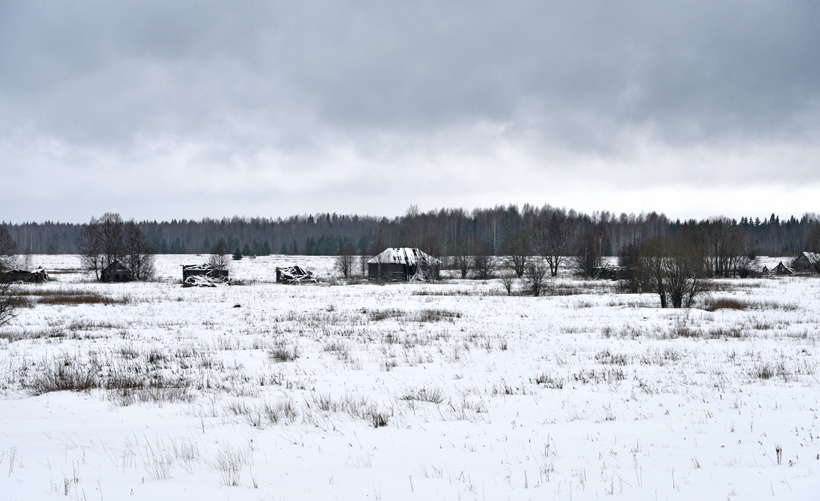
This is exactly what we did last winter, getting off the train in Nyandoma, a small town in the middle of nowhere, more or less halfway between Moscow and Arkhangelsk, then driving a couple of hours to Lake Lacha, in the Kargopol district. Quiet Kargopol, with its 10,000 souls, was once a booming merchant town. It was already a trading post in the 12th century (see my history of the Pomors). Then, in the 16th century when Arkhangelsk was founded, Kargopol found itself on the route between Moscow and that new trading center (then the only Russian seaport), and became one of the most prosperous cities of Russia. As in the rest of the region, its importance gradually faded after Saint-Petersburg was founded in the 18th century. Kargopol retains mementos of its past splendor, such as merchant houses and some of the many churches that the merchants built to show off their wealth, making the town at least as interesting to visit as Arkhangelsk.
But we’re not going to Kargopol today, we’re heading down the lake, further from human settlement! The largest lake in the Arkhangelsk region, Lake Lacha is the source of the Onega River, one of the major waterways of the White Sea basin. “Shallow water (greatest depth about 5.4 m), muddy peaty bottom and swampy shores. Freezes from November to May,” says The Great Soviet Encyclopedia. A few tiny villages are scattered along the shore, and in an isolated spot on the eastern side stands our destination: the Kolokol tour base.



In winter, the Kolokol tour base mostly hosts Russian weekenders, who split their time between ice-fishing on the lake and indulging in a good old vodka spree. We, on the other hand, are here to explore the area on snowmobiles, cutting through the swamps and driving on old forest trails to visit nearby churches and abandoned villages. And, okay, also to do a little bit of fishing and down the occasional shot of vodka.
Sergey, a local hunter, is coming with us to lead the way – not an easy task when the forest has reclaimed most of the trails and they need to be trimmed with an ax or a saw every five meters. He insists on bringing his gun with him, because, he says, he never goes into the woods without a purpose. It’s not a bad place to be a hunter; the area is rich in small and big game (beaver, brown hare, wolf, elk, brown bear), game birds (capercaillie, black grouse, hazel grouse, owl) and waterfowl (swan, many species of ducks). Though, of course, none of the animals are gonna sit pretty waiting for Sergey while we’re tearing the silence with our snowmobiles.
It takes a little while to get accustomed to the idea that as long as there’s no large tree in front of you, you can just step on the gas, and the shrubs that cover what once might have been a trail will yield. Apparently, we’re the first riders to venture to some of these places not just for this winter, but for several seasons. We make a pit stop at Sergey’s riverside cabin for a quick toast of vodka, chased with salo (pork fat).
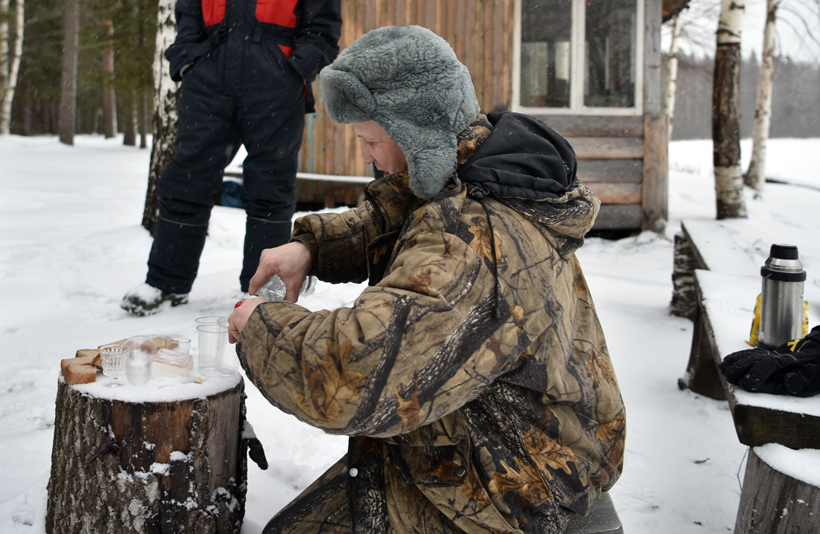
After visiting the Church of St. George the Victorious in Naumovskaya, we head to Lake Kolkovo (around 20 km east of Lake Lacha) for some undisturbed fishing. Progress soon becomes very difficult. Even with a GPS, we have to backtrack on several occasions. Sergey’s constantly walking ahead of us with his ax to cut away fallen tree trunks and large branches. Our snowmobiles roll over on their sides a few times, and the forest gets so dense that I doubt there’s ever been a trail at all. We’re getting close to the lake, but we risk running out of daylight. Eventually, we have to turn around. We stop to explore an abandoned village on the way back.
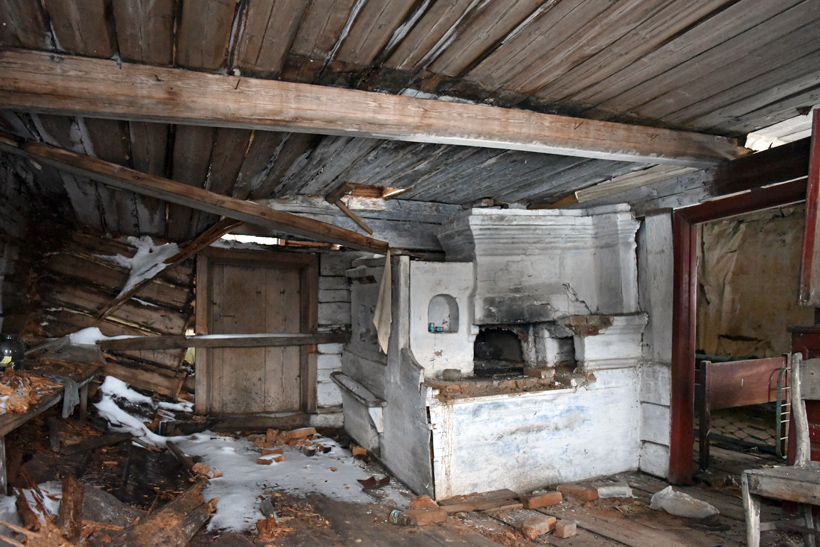
We’re not giving up altogether on fishing though, and we’re heading back to Lake Lacha. The lake is home to many species of fish: perch, pike, burbot, zander (a relative of the American walleye), common bream, silver bream, blue bream, common roach, ide, ruffle, and more.
We’d already spent some time on Lake Lacha the day before, ice-fishing like tourists: we got off our snowmobiles, cut some holes, played with a fishing rod for a few minutes to snap pictures while our guide set some tip-ups, then remounted and went back to the base, with the dubious hope that some really dumb fish would fall for our bait and stay hooked all day. We’ve been ice-fishing enough to know that the chances are slim, but it never hurts to try…


Now’s the time to check those tip-ups: it turns out the lake’s low on dumb fish, and we haven’t caught anything. Some smarter fish even managed to eat our bait and get away with it! Luckily, there are some local fishermen nearby who actually sat there all day, didn’t use fishing merely as an excuse to get drunk, and were therefore more successful. Some of them surreptitiously ditched the rods that turn fishing into a hobby, in favor of the less legal nets that turn fishing into a means of subsistence and trade. And they’re happy to sell us their catch.! We return to the base with “our catch” of burbot and zander, and we (meaning mostly Natalya, the base’s chef) are ready to cook.
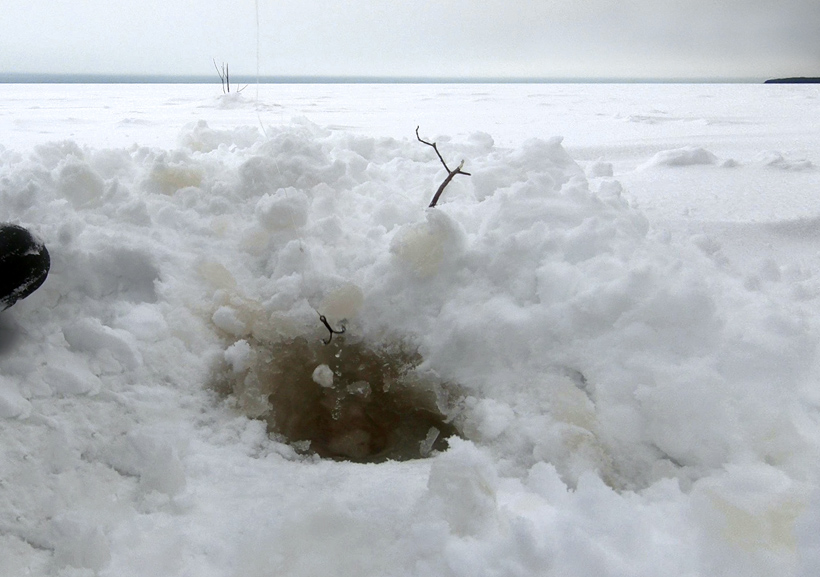
First, burbot soup. Burbot (aka eelpout) is the only freshwater member of the cod family. It has a circumpolar distribution, above the 40°N latitude, but because of its affinity for cold water, it’s most common in large lakes and northern rivers – especially in North America and Europe (if you happen to live in New York State, like me, here is an article about where to find it). “Strange that I’ve never heard of it,” you might think! Perhaps that’s because burbot is often considered a trash fish. As a tenacious predator, it’s detrimental to so-called game fish (in other words, burbot eats the fish that anglers love to catch with cute little colored feathers they call “flies”). Furthermore, burbot is profusely coated in a protective slime that helps regulate its body temperature and metabolism, and people often find that disgusting. Its single chin whisker doesn’t look all that attractive either.
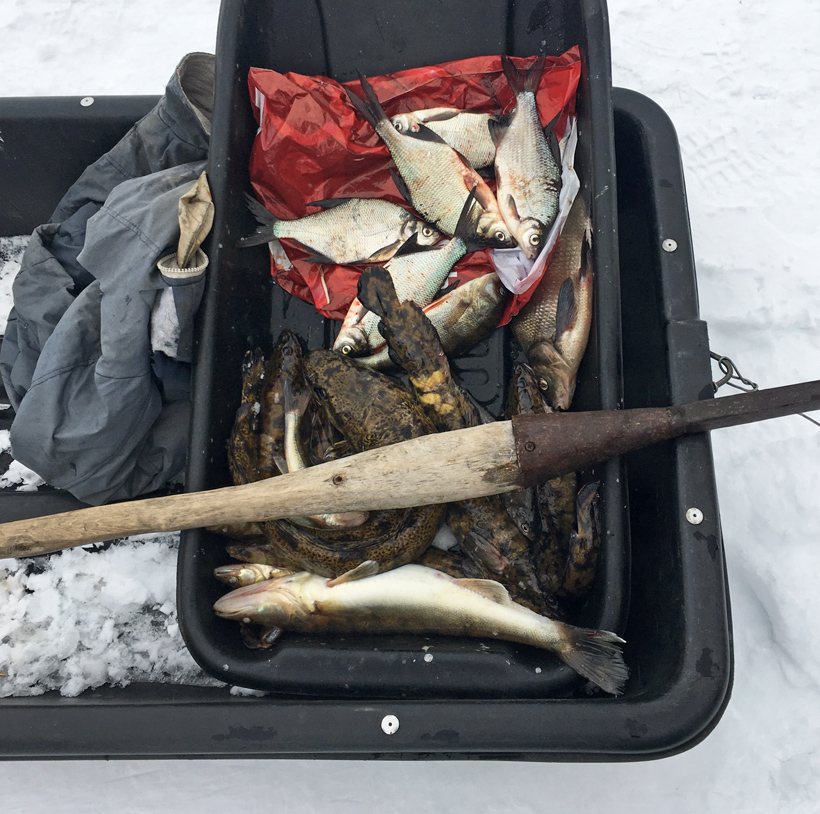
Yet the burbot is highly regarded by some. In Finland, its meat, roe, and liver are considered delicacies. With a length easily reaching over half a meter, burbot’s fillets are enough to feed several people. And just like cod liver, burbot liver is rich in omega 3 and vitamins A and D. There are annual eelpout festivals in North America (the fish’s gluttony makes it fairly easy to catch), and some claim that when cooked, it tastes a bit like lobster.
Our burbot soup is simple: cross-cut chunks of fish, potatoes, onions, and the liver, seasoned with black pepper. It’s my first time eating burbot. Like many freshwater fish, it doesn’t have a ton of flavor. I think the lobster claims are far-fetched. Still, it’s pretty good and the texture is both firm and a bit flaky like cod. The liver is tender and delicious, no doubt thanks to its high fat content.
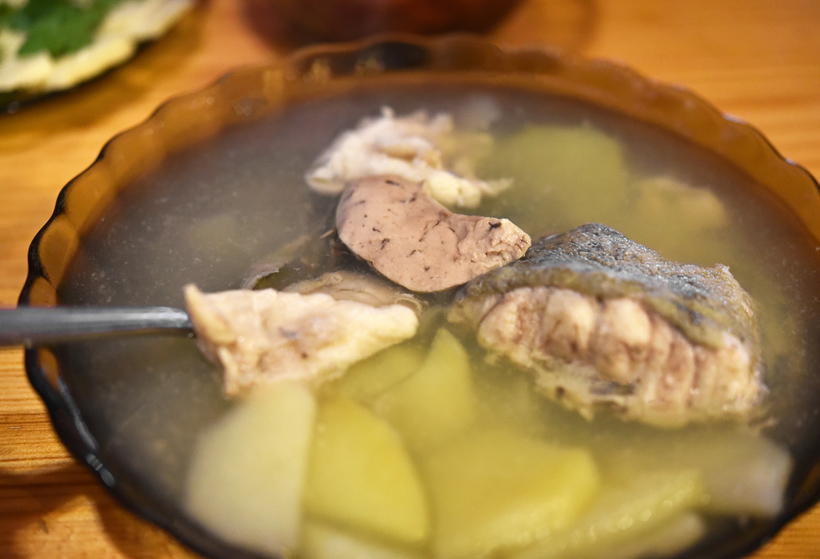
Our other catch, the zander, is baked whole in dough to make what’s called a rybnik (ryba means fish in Russian) – a kind of unpretentious coulibiac. Walleye/zander is a prized freshwater fish, and I’ve caught some on several occasions back in New York. European zander is widely distributed across Eurasia, and American walleye is popular in most Northern US states (particularly in Minnesota) and in Canada (with commercial fisheries in the Canadian waters of the Great Lakes).
While the recipe is simple (roll pie dough, put whole fish in it, bake), this is a great way to prepare walleye, and I wouldn’t mind trying it with my own catch next time I have the opportunity. As the fish contains relatively few bones, it’s well suited to be prepared whole.



During a different meal, we get to try another fish from Lake Lacha: vendace, aka European cisco. This is another highly esteemed species, this time from the Salmonidae family. Traditionally, it’s one of the most important products of commercial freshwater fisheries in many parts of Fennoscandia. Vendace roe is considered a delicacy (again) in Sweden, in particular in the Bothnian Bay where it has a PDO (Protected Designation of Origin) status under the name Kalix löjrom (Kalix vendace roe).
I assume that the vendace we’re eating were caught during the spawning season in the fall, and then frozen. They’re similar in appearance to whitefish, and just like whitefish, they’re delicious when hot-smoked whole. Here, the whole fish have been dredged in flour and fried in a pan, and we’re having them with plain rice. Not bad at all! The flavor is mild but pleasant, the texture is great because it feels quite moist (perhaps the fish had fattened before spawning), and if you remove the central bone, you can pretty much eat the fillets without worrying about the small bones.
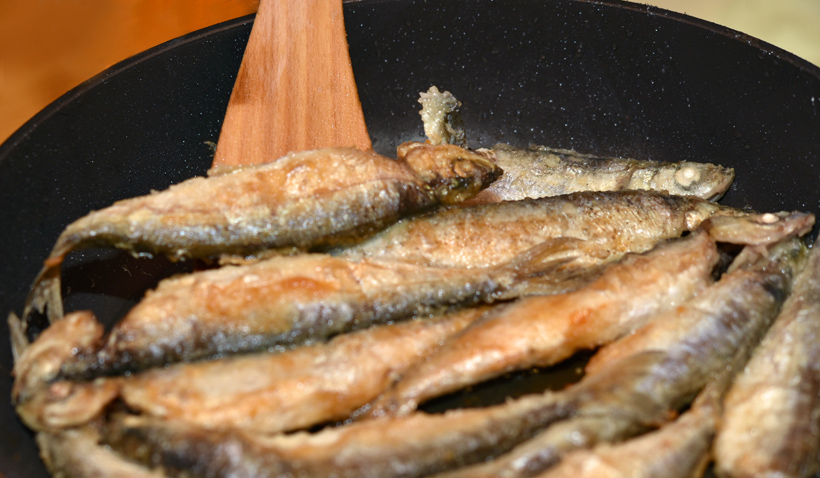
And we get to stuff ourselves with vendace roe too! As you’d expect from a fish this size, the eggs are tiny (like whitefish roe, if you’ve ever tried it). The caviar, with its appealing bright orange color, is subtle and tasty. I love fish roe in general, but I don’t know if I’d rate vendace significantly higher than pike or whitefish. That being said, it’s great to spread on a variety of things: any kind of baked good you have handy, or even the fried vendace themselves.

Since we’re about 300 km from the sea and in the middle of nowhere, fish isn’t the only food on local tables, especially for those locals who don’t fish. Pork and chicken are the meats of choice, and a hearty pork stew is welcome after a whole day out in the cold. Russian stews are often very straightforward: meat, herbs and spices (bay leaf, pepper), maybe onion, and that’s it. Occasionally, another vegetable such as carrot is added to the pot, or maybe some berries.

Remember I mentioned that the region is rich in big game? In Kargopol, you can buy jars of locally made elk or bear stew. We opted for the bear (this is Russia, after all), and Natalya prepares it for us at the tour base.
A good source of vitamins and amino acids, bear meat is alleged to help cure a multitude of ailments in Russia: digestive disorders, weakened immune systems, heart disease, lung disease, joint disease, and other chronic conditions. In folk medicine, it seems to be second only to bear fat, which is supposed to help with pain relief, healing open wounds, stomach ulcers, gastritis, rheumatism, arthritis, tuberculosis, pneumonia, bronchitis, eczema, skin care, and hair growth. Makes one wonder why we don’t eat bear more!
Bear meat is most commonly marinated, then braised or boiled in a soup, although meat from younger animals may not require marinating and can be fried instead. Then there are the bear paws, a delicacy (another one!) usually baked with pork fat, garlic, and pepper. In today’s stew, the tender braised meat has that gamey taste that I like, but not to a degree that would make it unpleasant. This is also a simple stew; I don’t detect anything other than meat and the fresh herbs sprinkled on top.
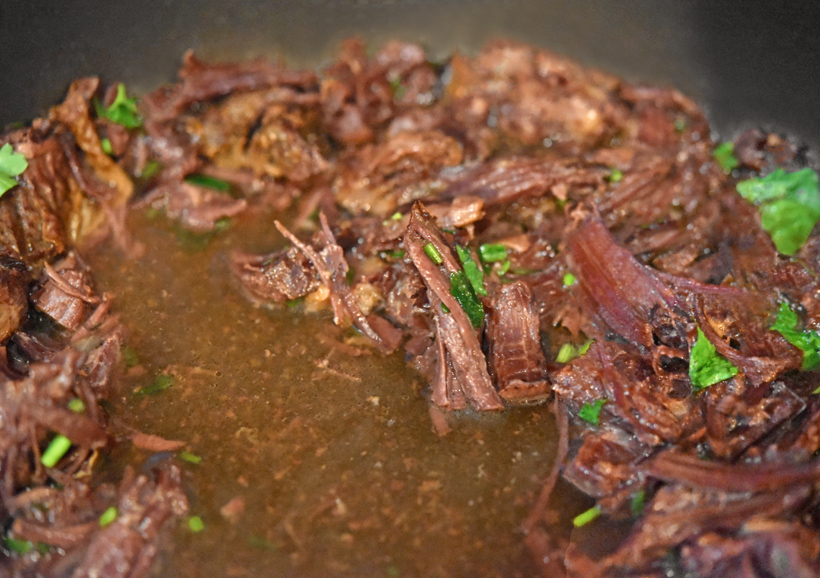
There’s one last dish that we prepare all together and eat during our stay on Lake Lacha: small potato pies called kalitkas. But you’ll have to wait for my next post to learn more and get the recipe!

